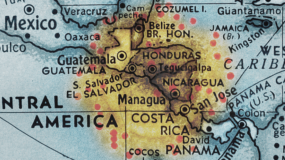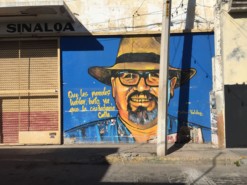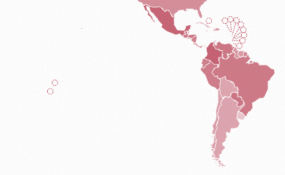The strategic use of violence by criminal organizations is becoming a concerning new trend in Mexico. In August 2022, the country witnessed one of its most violent weeks in recent history.
The criminal landscape in Mexico has changed over the last two decades. Whereas, in the past, a handful of cartels dominated drug-trafficking operations, the current criminal environment is much more fragmented, and overtly violent. In the early 2010, as large cartels fragmented into numerous smaller ones, new criminal organizations operating in the country were spawned. These groups exert their territorial control by unleashing recurrent, strategically coordinated attacks on ordinary members of the public.
A string of violent incidents between 9 and 14 August underscored how much power these groups have amassed. In one chaotic week, over a dozen civilians were murdered as a result of violent turf wars between factions of the Cartel Jalisco Nueva Generación (CJNG) – one of the drug gangs emerging in the early 2010s. The group set fire to dozens of vehicles, shops, petrol stations and pharmacies across the country. This was not the first time criminal groups had launched attacks on innocent members of the public.
In June 2021, armed men pertaining to one of the factions of the Cartel del Golfo murdered over a dozen people in Tamaulipas. In October 2019, after setting fire to a number of vehicles in Sinaloa and launching a spree of coordinated attacks on civilians and military personnel, resulting in eight deaths, the Sinaloa Cartel forced the authorities to release one of their detained leaders, Ovidio Guzmán, and held the entire city captive for over 12 hours. Earlier, in May 2018, after a failed assassination attempt on the former state attorney of Jalisco, Luis Carlos Nájera, by the CJNG, the group set a number of buses on fire, resulting in multiple injuries and the death of a woman and her child.
Instrumentalizing fear
These coordinated attacks show how criminal organizations in Mexico have been leveraging calculated violence to retaliate against law enforcement institutions, demonstrate their strength to rival factions and spread terror among the population so that their demands will be met. From these incidents, organized crime networks appear to be deploying violence as a strategic tool of criminal governance. The August 2022 attacks in cities across Jalisco, Guanajuato, Chihuahua, Baja California and Michoacán – perpetrated by the CJNG and Sinaloa Cartel-affiliated groups – is a case in point. In particular, the CJNG and its allies have become efficient in strategically using violence against ordinary members of the public as a way of challenging law enforcement and advancing their interests.
This reign of terror not only affects the individual victims, but also weakens the economy, shatters the social fabric of affected communities and further undermines the already shaky rule of law in Mexico. As a result of the August attacks, curfews were imposed in Ciudad Juárez, public transport was temporarily cancelled, businesses closed and citizens were forced to hide in their homes. US consulates in Guadalajara and Tijuana released emergency statements warning US citizens to take extreme precautions and avoid conflict areas.
The country’s authorities have failed to develop responses to counter and contain these kinds of attacks, or to create a compelling strategy to address the situation. In a highly controversial response to the August attacks, the mayor of Tijuana said she would not allow ‘a single Tijuana citizen to pay the consequences of those who did not pay their bills’ – the inference being that she was placing the blame for these attacks on citizens who failed to meet extortion demands. Only after the attacks occurred did the authorities boost the presence of law enforcement agents and arrest some of the perpetrators.
A more robust response
The frequency, intensity and deadliness of these attacks appear to be an increasing pattern. In late August, criminal groups in Zacatecas (where the CJNG and a Sinaloa criminal organization are locked in a violent turf war) set fire to vehicles and blocked roads in retaliation to law enforcement responses. In early September, in simultaneous attacks in various parts of Guanajuato, five people were killed and seven others were wounded.
Authorities must consider that these calculated attacks on members of the public may well escalate if the leader of a criminal group such as the CJNG – which exerts territorial gang control over two-thirds of Mexican states – is arrested. If this were to happen, would they be prepared to contain the attacks and protect the lives of people on the street? How can the national gendarmerie force coordinate more effectively with police authorities to deter and contain these calculated acts of violence? Answers to these questions are never going to be straightforward, but authorities must ramp up the state’s response before criminal organizations launch an attack on citizens on a much larger scale.
El uso estratégico de la violencia por parte de las organizaciones criminales, dirigida principalmente a los ciudadanos de a pie, es una nueva y preocupante tendencia en México. En agosto del 2022, el país vivió una de las semanas más violentas en su historia reciente. Las autoridades deben contrarrestar urgentemente esta forma recurrente de violencia.
El panorama criminal en México ha cambiado en las últimas dos décadas. Mientras que, en el pasado, un puñado de cárteles dominaba las operaciones de narcotráfico, el entorno criminal actual está mucho más fragmentado y es abiertamente violento. A principios del 2010, cuando los grandes cárteles se fragmentaron en grupos más pequeños, surgieron nuevas organizaciones criminales, que cada vez más ejercen control territorial a través de ataques recurrentes y estratégicamente coordinados contra los ciudadanos de a pie.
Una serie de incidentes violentos ocurridos entre el 9 y el 14 de agosto puso de manifiesto el poder que han acumulado estos grupos. En una semana caótica, más de una docena de civiles fueron asesinados como resultado de las violentas guerras territoriales entre facciones del Cártel Jalisco Nueva Generación (CJNG), uno de los mayores grupos criminales que surgieron a principios de la década del 2010. El grupo prendió fuego a decenas de vehículos, tiendas, gasolineras y farmacias por todo el país. Sin embargo, no era la primera vez que grupos criminales lanzaban ataques contra ciudadanos inocentes.
En junio del 2021, hombres armados pertenecientes a una de las facciones del Cártel del Golfo asesinaron a más de una docena de personas en Tamaulipas. En octubre de 2019, tras incendiar varios vehículos en Sinaloa y lanzar ataques coordinados contra civiles y militares, derivando en ocho muertes, el Cártel de Sinaloa obligó a las autoridades a liberar a uno de sus líderes detenidos, Ovidio Guzmán, y tomó la ciudad durante más de 12 horas. En mayo de 2018, tras un fallido intento de asesinato del exprocurador de Jalisco, Luis Carlos Nájera, por parte del CJNG, el grupo prendió fuego a varios autobuses, hiriendo a múltiples personas y causando la muerte de una mujer y su hijo.
El miedo como instrumento de control
Estos ataques coordinados muestran cómo las organizaciones criminales en México han aprovechado la violencia calculada para tomar represalias contra las autoridades, demostrar su fuerza ante facciones rivales y sembrar terror entre la población para que se cumplan sus demandas. Con ello, los grupos del crimen organizado parecen estar desplegando la violencia como herramienta estratégica de la gobernanza criminal, como ocurrió en los atentados de agosto del 2022 en ciudades de Jalisco, Guanajuato, Chihuahua, Baja California y Michoacán provocados por el CJNG y grupos afiliados al Cártel de Sinaloa como Los Mexicles y Los Chapos. El CJNG y sus aliados se han vuelto particularmente eficientes en el uso estratégico de la violencia contra miembros del público como una forma de desafiar a la aplicación de la ley y promover sus intereses.
La estrategia de infundir terror no solo afecta a las víctimas individualmente, sino que también debilita la economía, desgarra el tejido social de las comunidades afectadas y socava aún más el ya tambaleante Estado de Derecho en México. Como consecuencia de los ataques de agosto, se impuso el toque de queda en Ciudad Juárez, se canceló temporalmente el transporte público, se cerraron los negocios y los ciudadanos se vieron obligados a esconderse en sus casas. Los consulados de Estados Unidos en Guadalajara y Tijuana emitieron comunicados de emergencia en los que advertían a los ciudadanos estadounidenses de que debían extremar las precauciones y evitar las zonas de conflicto.
Las autoridades del país no han desarrollado respuestas para contrarrestar y contener este tipo de ataques, ni han creado una estrategia convincente para hacer frente a la situación. En una respuesta muy controvertida a los ataques de agosto, la alcaldesa de Tijuana dijo que no permitirían que «un solo ciudadano tijuanense pague las consecuencias de quienes no pagaron sus facturas», con lo que se deduce que culpaba de estos ataques a los ciudadanos que no lograron cumplir con las demandas de extorsión. Además, fue solo después de que se produjeran los ataques que las autoridades reforzaron la presencia de agentes de la ley y detuvieron a algunos de los autores.
Una respuesta más contundente
La frecuencia, la intensidad y la mortalidad de estos ataques parecen ser un patrón creciente. A finales de agosto, grupos criminales de Zacatecas (donde el CJNG y una organización criminal de Sinaloa están enfrentados en una violenta guerra territorial) incendiaron vehículos y bloquearon carreteras en represalia a las respuestas de las autoridades. A principios de septiembre, en ataques simultáneos en varias partes de Guanajuato, cinco personas murieron y otras siete resultaron heridas.
Las autoridades deben tener en cuenta que estos ataques calculados contra los ciudadanos pueden intensificarse si se detiene al líder de un grupo criminal como el CJNG, cuyas facciones ejercen control territorial en dos tercios de los estados del país. Si esto ocurriera, ¿estarían preparados para contener los ataques y proteger la vida de los ciudadanos de a pie? ¿Cómo puede la Guardia Nacional coordinarse más eficazmente con las autoridades policiales para disuadir y contener estos actos de violencia calculados? Las soluciones a estas preguntas nunca serán sencillas, pero se debe intensificar la respuesta del Estado antes de que las organizaciones criminales logren coordinar ataques contra los ciudadanos a mucha mayor escala.



